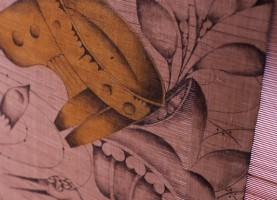

京都の絞り染めの歴史は古く、10 世紀頃に宮廷衣装として用いられた絞り染めが京鹿の子絞の原点で、立体感のある模様が小鹿の斑点に似ているためその名が付きました。現在では、京都でつくられる絹地の絞り染めを総称して京鹿の子絞と呼びます。複雑で精巧な柄構成が特徴で、疋田絞 、一目絞など多様な技法に専門性の高い技術が伝承されています。
Kyoto’s “shibori-zome”, or tie-dyeing, has a long and distinguished history. “Kyo-kanoko-shibori” originated from the type of tie-dyeing used for the garments of imperial courtiers around the 10th century. “Kanoko” means fawn, and refers to the fact that the pattern created by this method resembles the spots on young deer. Today, “Kyo-kanoko-shibori” is used as a general term for all tie-dyed silk fabric produced in Kyoto. Noted for its complex and elaborate patterns, “Kyo-kanoko-shibori” involves many different techniques such as “hitta-shibori” and “hitome-shibori”, requiring a high level of expertise that has been handed down from generation to generation.
一万粒以上の緻密な鹿の子絞の風合いを
インテリアとして楽しむ
A very fine Kyokanoko Shibori produced with over 10,000 grains. Ideal for interiors.
絞りの凹凸をデザインとして楽しむ
テキスタイルの遊びにみちたスカーフ
A design for enjoying the irregularity of tie-dyed fabrics.
Scarves based on the playful use of unique textiles.
手作業の「竜巻絞り」が生み出す
ツートーンカラーと繊細なプリーツ
“Tornado” tie-dyeing (Tatsumaki-shibori) by hand produces fine pleats and delicate two-tone colours.
日本の中世の染色、辻が花
タペストリーに再現された「幻の技法」
Tsujigahana – a medieval Japanese dyeing technique
A lost technique revived in tapestries.






